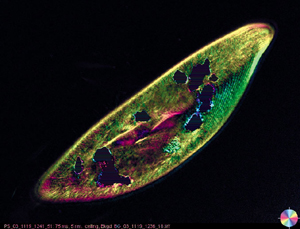| |

March 2004, Vol. 13, No. 3 | Return to Table of Contents
Brown and MBL Physicists Open Exciting Windows on Cell Biology
Ask Brown physics professor James Valles, Jr. what the best thing was about his recent sabbatical in the light microscopy lab of MBL's Rudolf Oldenbourg, and he answers unequivocally. "Windows." he says. "The opportunities for the future and the one over my desk looking out on the water."
These windows came largely as a result of the Brown-MBL alliance, which promotes interdisciplinary research and hands-on graduate education, and which recently enabled Valles to trade Brown's ivy for Cape Cod's seaweed in an intensive semester of research in Oldenbourg's lab.
 Why the sabbatical? Valles had a theory that the Pol-Scope-Oldenbourg's microscope that uses polarized light to view living cells without disturbing them-would play an important role in his efforts to use physics to understand cells. He also hoped to develop ideas for proposals to support a multi-year collaboration with Oldenbourg and MBL's Architectural Dynamics in Living Cells Program (ADLCP). Why the sabbatical? Valles had a theory that the Pol-Scope-Oldenbourg's microscope that uses polarized light to view living cells without disturbing them-would play an important role in his efforts to use physics to understand cells. He also hoped to develop ideas for proposals to support a multi-year collaboration with Oldenbourg and MBL's Architectural Dynamics in Living Cells Program (ADLCP).
"I had this idea that the Pol-Scope would be a useful, complementary tool to our use of strong magnetic fields to [non-invasively] manipulate cells and learn about them," says Valles.
Although the thought of somehow collaborating with Oldenbourg and ADLCP had occurred to Valles several years ago, when he initially read about Oldenbourg's work, the first window of opportunity emerged when both scientists attended one of the early meetings about the Brown-MBL alliance. "I, and I think Rudolf as well, felt that the alliance immediately endorsed such collaborations as long-term ventures," says Valles.
So he spent fall 2003 alongside Oldenbourg, learning about the function and
theory of the Pol-Scope, and looking at the single-celled protist, Paramecium (photo above).
To Valles- delight, his theory was easier to prove than expected. "We learned that the Pol-Scope is uniquely sensitive for revealing the source of magnetic-induced changes," he says. Equally important was the fact that the Pol-Scope allowed him to observe his subjects without disturbing them, a key component of his research.
From there, Valles and Oldenbourg saw powerful possibilities, including the creation of a new cell biology tool that would combine Pol-Scope technology with the use of intense magnetic fields. The two scientists recently completed a grant to support this effort.
"Such [tools] do not exist at present and would allow us to exert forces on living cells without touching them and observe the consequences," says Valles. The grant also features an educational component, which would "help bring Pol-Scope technology to the minds at Brown."
While it is still too early to tell whether the grant will be funded or how Valles- and Oldenbourg's work together will ultimately impact the field of cell biology, what is clear is that their combined efforts are the positive result of Brown's and MBL's joint decision to encourage collaboration.
"The Brown-MBL alliance is a unique opportunity I'm glad the administrators have grabbed hold of," says Valles.
|